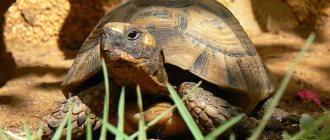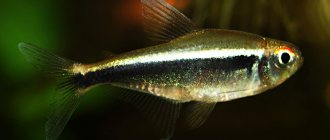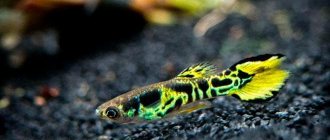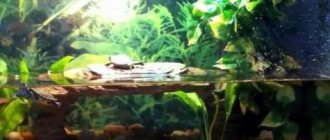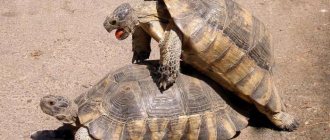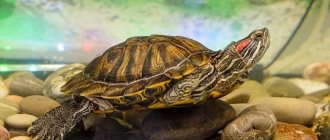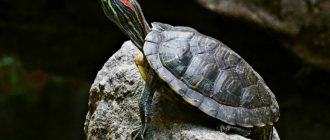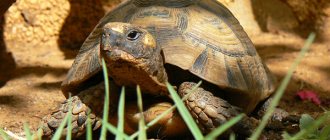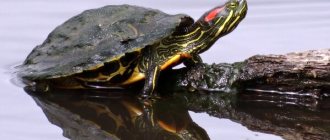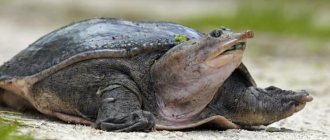In the article I will consider the conditions for keeping and breeding the red-eared turtle. This is one of the most popular three species of pet reptiles. I will list its main features: color, size, lifespan, types. I’ll tell you about how to properly keep her, feed her, whether she is friends with other animals, what are the features of caring for her and breeding, and how to set up a turtle. I will list the signs that your dwarf pet is about to go into hibernation. I will describe how and where to set up an aquaterrarium and how to wash it.
How many types of domestic ornamental reptiles are there?
The species is divided into 13 subspecies. Among them, the most common are:
- “red-eared slider” (Florida turtle) is the most striking representative of the species, since it has a color that fully corresponds to the above description;
Red-eared slider - “yellow-bellied slider” - the head is black, covered with yellow stripes, there is no red spot;
Yellow-bellied slider - Cumberland (Trusta or yellow-eared) - instead of red spots in the ear area, there are yellow ones.
Skulls of Trust
These species are the most suitable for keeping at home. But the “yellow-bellied slider” is the most finicky pet among its fellows. In addition, people who cannot afford to keep a large pet should pay attention to the mini option. The size of such animals does not exceed 11-13 cm, so the aquarium for them is smaller than for ordinary ones. But when it comes to caring for themselves, they are no less demanding than ordinary ones.
Determination of gender
Before breeding reptiles, you need to make sure there are male and female individuals. The female may lay eggs without mating, but they will not be fertilized and no offspring will be produced.
It is possible to determine the sex of turtles when they are one year old. It is advisable to take individuals of the same age for comparison. You need to pay attention to the following signs:
- males are generally smaller than females;
- Boys' claws are longer;
- Males can be identified by the concave lower part of the shell.
Mating of red-eared turtles occurs after they reach sexual maturity, which occurs faster when kept at home than in nature. Males become ready to reproduce after 4 years of life, and females after five.
The red-eared slider is capable of producing offspring at the age of 5 years
Conditions of detention, care at home
An adult requires an aquarium with a capacity of more than 130 liters, which will contain:
- a large sloping island with a rough surface;
- water heater;
- Ultraviolet lamp;
- filter;
- lamp;
- thermometer.
The water should be changed once every 6-8 days.
These are aquatic animals, but they cannot stay under water all the time. They love to walk along the bottom, but due to the lack of gills, they need to constantly rise to the top to breathe. Therefore, the height of the water should not be much greater than the width of the shell (so that the animal can swim and turn over freely). The optimal water temperature level is +23 degrees.
The terrarium should be spacious
The land in the aquarium should occupy a quarter of the total area. An incandescent lamp is installed above it (to warm the air and the island), which should work daily for 9-11 hours.
Red-eared turtles do not need soil or rocks at the bottom. But when choosing such decor, you need to remember that they must be large in size so that the turtle does not eat them.
It is recommended to keep these animals with turtles of the same species and age.
Reproduction of red-eared turtles in captivity
- home
- Animal world
- Reproduction of red-eared turtles in captivity
| Date: 6 May 2012 | Category: Animal world | Comments: No comments |
Turtle owners often wonder whether it is possible to breed red-eared turtles in captivity. Reproduction of red-eared turtles in captivity is not difficult for the owner; often the females themselves lay eggs, but turtles, like some other reptiles, also lay unfertilized eggs, like those chicken eggs that we are used to buying in the store.
There is no point in incubating eggs if your pet laid them while living alone. You will get nothing but wasted time and disappointment.
However, if red-eared turtles living in an aquaterrarium, and there is confidence in the presence of turtles of both sexes (I have already written about how to determine the sex of a red-eared turtle), and even more so, if mating has been noticed, then incubating the laid eggs definitely makes sense. The most preferred season for mating is February-May. You can stimulate the reproduction of turtles by changing the water and increasing its temperature.
Before mating, you can observe the original and very amusing courtship of the male red-eared turtle. It swims in front of the female, tail first, and tickles her cheeks with its claws, while creating small vibrations with its front paws. Also, males often hit the shell of their chosen one with the edge of their shell.
Similar behavior is observed even in immature males. The female, ready for reproduction, allows the male to approach her. Mating occurs in water. The average duration of an act is 5-15 minutes. Fertilization is enough for four to five clutches. However, sperm can remain in the female genitals for up to two years!
Egg laying occurs on the shore from April to September. The female moistens the sand with her own liquid from the cloacal bladders, after which she digs a hole 10-20 cm in diameter with her hind legs, and lays from 6 to 20 eggs, weighing 5-15 grams, and 3-4 centimeters in diameter. After which the female carefully and carefully buries the clutch.
As mentioned above, to stimulate the reproduction of red-eared turtles , it is advisable to increase the temperature of the animals, and you can also increase the duration of daylight hours. And be sure to create an artificial beach, for example, by placing a cuvette in the terrarium, into which wet sand is poured in a layer of 3-5 cm. And in order for the turtles to crawl out onto the impromptu “beach”, you will need to attach a “ladder” to the side of the cuvette, for example, made of plexiglass , with holes drilled in it. The holes are needed so that turtles can cling to the “ladder” with their claws when climbing out of the water. If a turtle has laid eggs directly into the water, for example, in the absence of a shore, they must be immediately removed from the water!
Experienced experts recommend using a separate terrarium or aquarium with a capacity of 90-140 liters for mating , with settled warm water, the depth of which should not exceed 10-12 cm. More than that should not be due to the fact that the male, keen on mating, may inadvertently prevent the female from the ability to breathe. If mating of the turtles does not occur, the couple should be seated for two to three days, after which you can try to repeat the idea.
Share news:
Be sure to check out these posts as well:
- Red-eared turtles turn out to be slow chameleons John Rowe and his colleagues from Alma College discovered during a multi-day experiment...
- Adelaide Zoo's Swamp Toad Turtle Cubs Australia's Adelaide Zoo has unveiled four new swamp toad turtle hatchlings, which arrived...
- Turtles Turtles are reptiles with a peculiar, dorsoventrally flattened (going in the direction from the upper part of the body...
The entry has tags: aquaterrarium, red-eared turtles, reproduction of red-eared turtles. Reprinting of any site materials without an active link is prohibited!
Feeding, nutritional habits, what kind of food and food can a turtle eat
Red-eared reptiles are omnivores, but you cannot feed them:
- pork;
- lamb;
- crab sticks;
- vegetables (except carrots).
The diet should be varied.
Carrots are allowed to be fed once every 25-30 days.
It is extremely rare to give food insects, mealworms, bloodworms.
Be sure to feed:
- low-fat, non-gutted fish (river) - give once every 10-14 days;
- beef liver;
The meat is given raw.
- snails (except ambers);
- crickets;
- feed cockroaches;
- earthworms;
- aquarium fish (guppies, zebrafish);
- plant food (in older individuals it should make up 50% of the diet): aquarium plants, lettuce, dandelion leaves.
The diet of a red-eared slider should include meat.
Up to 12-13 months, they are fed daily, older ones - once every two days.
Disease symptoms: lethargy, swollen eyes, white spots
Red-eared turtles are susceptible to diseases, just like humans. Being in a confined space, they get sick much more often than in the wild.
| Disease | Symptoms | Treatment |
| Pneumonia or any other type of cold | The turtle sneezes. Mucus discharge appears from the nostrils - runny nose. Lethargic and motionless. Poor appetite. Rapid breathing through the mouth | Treatment boils down to a course of antibiotics, which can only be prescribed by a qualified veterinarian, based on the age and size of the animal. |
| Shell diseases | The shell delaminates, it becomes soft. Chipping appears on the surface. If it's not molting, it's a disease. | Associated with calcium deficiency. Increase calcium content in the diet. Take your turtle out into the sun as often as possible |
| Fungus | A common problem that occurs when keeping a home. Unnatural white spots and gray irregularities appear on the shell | It is treated by applying Clotrimazole to the damaged area. The ointment is left overnight, placing the animal in dry heat on dry land. |
| Conjunctivitis | Eyes swollen. Purulent discharge appears. Lethargy and loss of appetite | Eyes are washed twice a day. Change the water in the aquarium more often. Tobrex or ophthalmoferon drops are dripped. Veterinarian consultation required |
| Intestinal infections | The turtle does not open its eyes and refuses food. Sleeps for a long time or does not sleep at all | Be sure to show it to a doctor. Only he can determine the true cause and prescribe treatment. |
| Parasites | Poor appetite, unnatural behavior. Lethargy | Treated with medications prescribed by a veterinarian |
Red-eared turtles are not marine turtles, so they are often kept indoors. Many different diseases are associated mainly with poor care.
Important! You cannot self-medicate. This will lead to the death of your pet.
Sleep is also very important for your pet. The red-eared turtle sleeps in different ways. Much depends on the conditions of detention, water temperature, nutrition. The animal does not hibernate when kept at home.
Turtles sleep mainly on land. If the oxygen supply is sufficient, it can sleep under water.
How to wash? Turtles wash themselves. For colds, make a decoction of chamomile. When the water temperature drops to 30 degrees Celsius, the turtle is bathed in this bath.
Useful video
Share this post
- Related Posts
- What kind of lighting should be in the aquarium?
- Review of dogs that look like bears
- Description of parrot fish and how to care for them?
- What you need to know about Pekingese dogs, how to care for them at home?
- How to keep shrimp in an aquarium, what do they eat, who do they get along with?
- Description and characteristics of rated dog breeds by intelligence
Where does a small reptile spend the winter and can it hibernate in an aquarium?
When the correct temperature is maintained, the red-eared turtle does not hibernate. But there are exceptions. They carefully prepare for hibernation.
The temperature at the hibernation site is maintained at +1/+6 degrees.
Two months before the start, the reptile should be well fed, increasing the frequency of feeding and expanding the diet. You cannot feed the animal during the last week. The pet should get used to this temperature gradually.
Some individuals hibernate regardless of the conditions of detention
The place should be with high humidity. To do this, you can make a mixture of leaves, which will allow air to pass through, and moss, which will retain moisture.
Organizing hibernation at home is a difficult process, so it is important to provide sufficient care to avoid the need for it.
Preparation period
Red-eared turtles mate at home reluctantly, and the owner has to make considerable efforts to obtain offspring. The diet of reptiles before mating should be high in calories and rich in vitamins. Be sure to provide protein foods (minced meat, worms, a mixture of dried crustaceans) and plant foods (pieces of fruits and vegetables, herbs, beet and carrot tops).
READ Do-it-yourself terrarium for Achatina snails
A female ready for reproduction may become restless and refuse to feed. A pair of mature turtles must be placed in a separate spacious aquarium. The optimal water temperature is 25°C. It must be taken into account that, carried away by the mating process, the male can press the female to the bottom. To prevent the turtle from choking, the water level should not exceed 10 centimeters.
If you have more than two red-eared turtles, you should house the male and female in pairs
Reproduction
Males reach sexual maturity at the age of 3-5 years, and females at 5-7 years. The sex of turtles can only be determined when the carapace length is at least 10 cm.
When mating, the male inserts his sexual organ into the female’s cloaca, climbing onto her back and holding onto her shell with his claws. A plastron concave inward helps him successfully carry out this procedure. Mating lasts from 15 to 20 minutes.
Editorial: Pecilia Sunset
Pregnancy lasts 80-85 days. The female climbs ashore and digs a hole on the wet sandy shore and lays eggs in it. There are from 5 to 12 eggs in one clutch. Depending on the climate, incubation lasts two or three months.
With the help of an egg tooth, the babies break through the eggshell and get out into the wild. They immediately rush to the saving surface of the water. Many of them do not have time to escape and fall into the clutches of predators.
Species features
In the wild, exotic reptiles are distributed throughout the United States, Mexico, all of Central America, Colombia, Venezuela, Great Britain, Spain, Israel, South Africa, Japan, Vietnam, Thailand, Malaysia and Australia. This species of freshwater turtle received its name due to the clearly visible red or orange stripe located in the area of the eyes and neck.
The reptile is medium in size, the length of its shell ranges from eighteen to thirty centimeters. Females are larger than males. Representatives of this species have well-developed senses of smell and vision, which compensate for poor hearing. The animals also have weak vocal cords, but this does not prevent small reptiles from occasionally hissing, snorting and squeaking.
The average life expectancy is twenty-five years, but there are also centenarians who can overcome the half-century mark. This largely depends on the correct keeping of red-eared turtles at home.
The average lifespan of a red-eared slider is twenty-five years.
